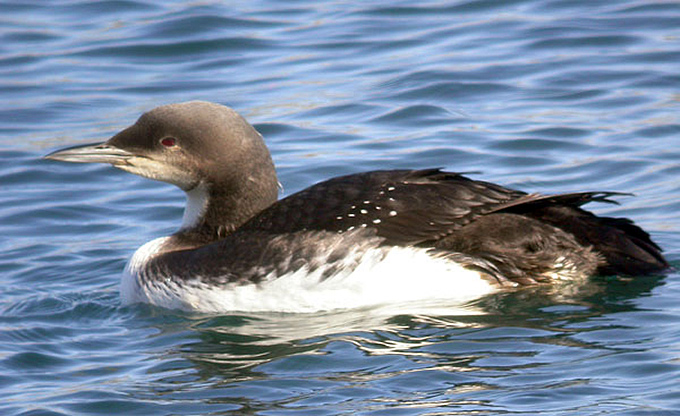 | E-mail to Birds Korea |
 | KWBS |
in the Region
 | The Oriental Bird Club |
 | BirdLife International (Asia) |
February
Cold winters mean both temperatures and birding are similar to January, while increasingly frequent mild winters are marked by brief spells of rain or sleet, often followed by warmer sunshine, with maximum temperatures rising to 15°C or more in the southeast.
Many wildfowl are on the move by mid-month: Tundra Beans, Greater White-fronted and usually Swan Geese can be found at the Han-Imjin. Most Baikal Teal start to depart and by month’s end can become difficult to find in southern locations. Rooks and Daurian Jackdaws begin to move back into the Nakdong valley and near Gunsan. February sees the start of crane migration, with Hooded and White-napeds moving into South Korea from Japan. The now very scarce Relict and the rather more widespread Saunders’s Gull peak at several tidal-flat sites. At the end of the month the first spring migrants, such as Far Eastern Curlews, Hoopoes and Japanese Lesser Sparrowhawks start to arrive.
February highlights in recent years have included records of Baer’s Pochard, Steppe Eagle, Least Auklet, Snow Bunting, and Common Redpoll.
Outstanding national rarities in February include the second record of Green-winged Teal in 2008, and the second Arctic Redpoll, on Heuksan Island in 2009. Recent Korean firsts in February include Thick-billed Murre in 2006 and Himalayan Vulture in 2007.
(The following records are a compilation of our own sightings and records sent in by other observers. As well as being posted on the Birds Korea website(s), selected records are also forwarded to other Korean-language birding websites; records of threatened species are arranged and forwarded to Birdlife International and national authorities when appropriate; flag images and records are passed to bodies responsible for their coordination throughout the flyway; and all records sent to us are used to compile annual reports and to support the evolving understanding of the status of many of Korea’s birds.)
East Coast Winter Trip Report, February 25 - 26


I had the opportunity to spend the weekend with six fellow birders from Birds Korea (of six different countries), on a trip to the east coast for some sea-watching and hopefully a pelagic trip (fell through due to weather). We were able to see 57 species over the course of two days, including a few real good looks at some nice birds (more on this later). The weekend started out with snow on the drive in and stayed brisk and breezy for the remainder of the weekend, which made for some cold fingers and noses, as well as some tricky birding. A few things really stand out to me from the trip.
First, to be in the company of six fellow Birds Koreans was special. I found out that it’s definitely the people that make this organization what it is. There were seven very different people present, though everyone’s passion for birding and conservation was evident. I learned a lot about myself being around such good people and great birders. Second, and this goes hand-in-hand with the first point, I thoroughly enjoyed the times we weren’t “eye-on-scope” as much as when we were focused on the birding. Saturday evening we stayed in Pohang and were able to share great conversation over good pizza. To sit and talk conservation and the science of birding with Dr. Moores, Mr. Loghry and Mr. Ju Yong-ki Nim was ONE-OF-A-KIND!!
Lastly, to have the opportunity to hone my skills next to some of the best birders on the peninsula was a “once-in-a-lifetime” opportunity. I never realized that there really is an “art” to scoping. Anyone can set one up and look into the eyepiece and see some birds, but to get to most out of one takes practice and patience. Before this weekend I was something of a field mark birder, too. To find a field mark and move to the next bird was my game. Doing it that way, though, was just scratching the surface and leaving me without ever really knowing a bird. To take the time to sit and really break down a bird until I know everything there is to know about it is the only way to take my skills to that next level (that I didn’t really know existed until this weekend). Dr. Moores is a meticulous and patient teacher/mentor and it was through spending time with him that I take away the most from this weekend. I owe him a great debt of gratitude.
And now for the birds:
Saturday we saw small numbers of Common Pochard and White-winged Scoter moving north along the coast. Distant looks at Ancient Murrelet and Rhinoceros Auklet were common throughout the day. Of the gulls seen on Saturday, the highlights were a Glaucous-winged Gull and a couple Glaucous Gulls, Taimyr Gulls and a few very smart Common Gulls. At one of the many lagoons we stopped at, we got fantastic looks at an Artic Loon and learned a lot about loon identification at that time. Being that the focus of the weekend was on seabirds we only noted a handful of passerines. Most noteworthy (for me) was a single Siberian Accentor calling from a wooded area at the base of a light house and a flock of around 100 Bramblings moving through some trees near to where we were birding at one of our stops. Other noteworthy birds from the day were Harlequin Duck, large numbers of Red-Breasted Merganser, Common Merganser, Red-throated Loon, Red-necked Grebe, Slavonian Grebe, Pelagic Cormorant, Falcated Duck and Northern Goshawk.
Sunday, with the help of three more Birds Koreans who came in overnight, we birded the Pohang area and the Guryongpo peninsula. The first noteworthy event for Sunday was seeing two large flocks of Russet Sparrows in a village just north of Pohang, totalling about 300 individuals- the largest number known to Birds Korea of Russet Sparrow seen on the mainland of Korea. The other noteworthy sightings were the probable Caspian Gull Larus cachinnans and Steppe Gull Larus (heuglini) barabensis. We all got great looks at them and Dr. Moores used this opportunity to teach us even more about gull identification (Boy, did I learn a lot about gulls this weekend!!). The highlight of the day, for me, was one of the last stops of the weekend, on the northern tip of the Guryongpo peninsula. Large numbers of seabird species were to be found here, including great close-up looks of Ancient Murrelets and Rhinoceros Auklet, the first male Harlequin Ducks of the weekend, and some great looks at loons and grebes. Other birds of note for Sunday were a Meadow Bunting singing from a treetop, a small flock of Sanderling poking through some rocks along a beach, a Greater Scaup and a couple small flocks of Greater White-fronted Geese and Whooper Swans on the wing.
It was a fantastic weekend and I look forward to the next one.
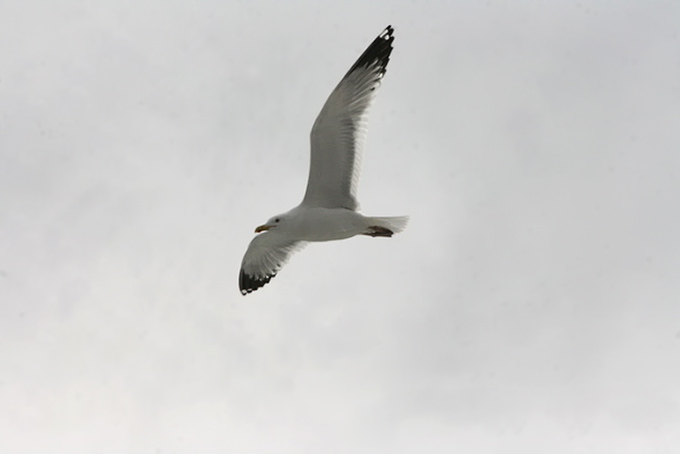
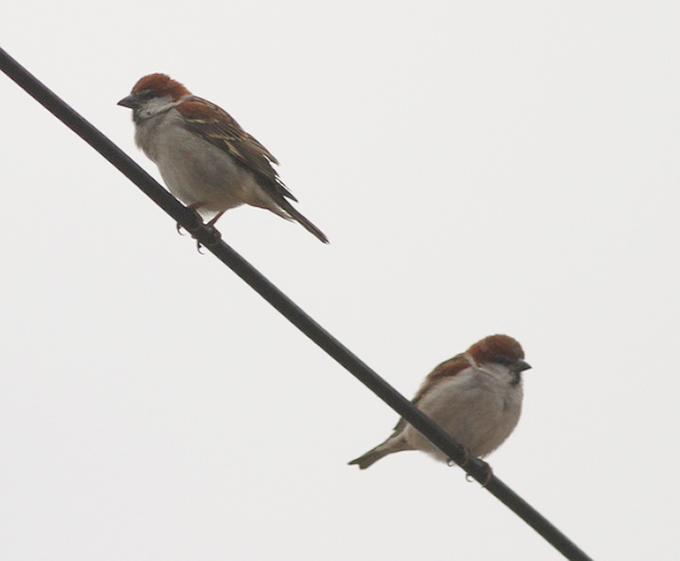
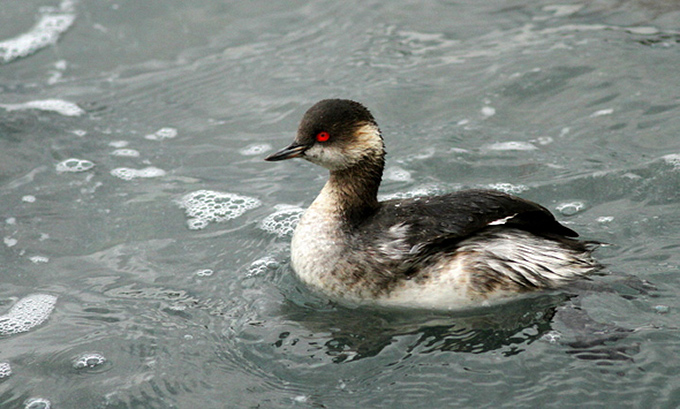
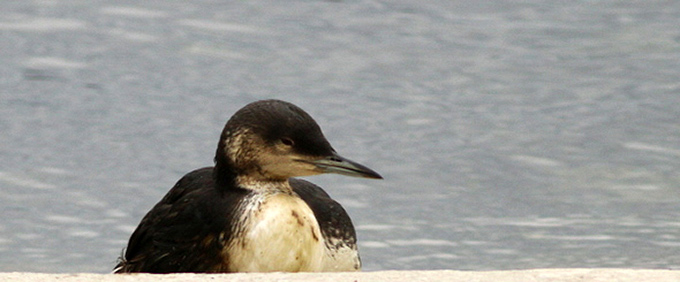
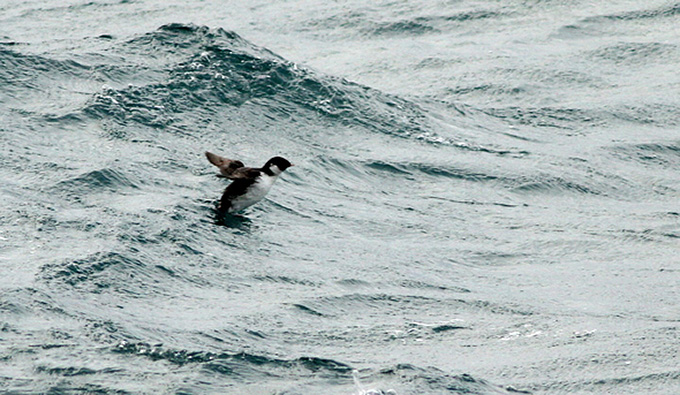
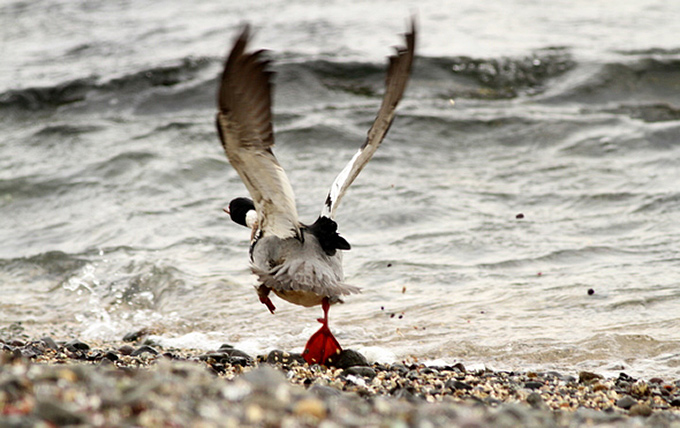
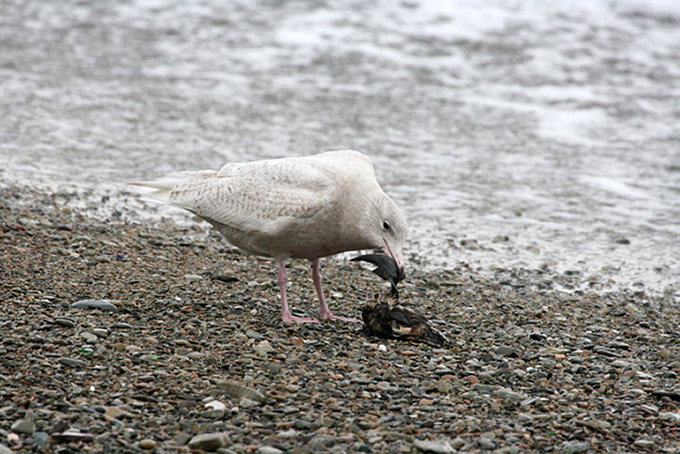
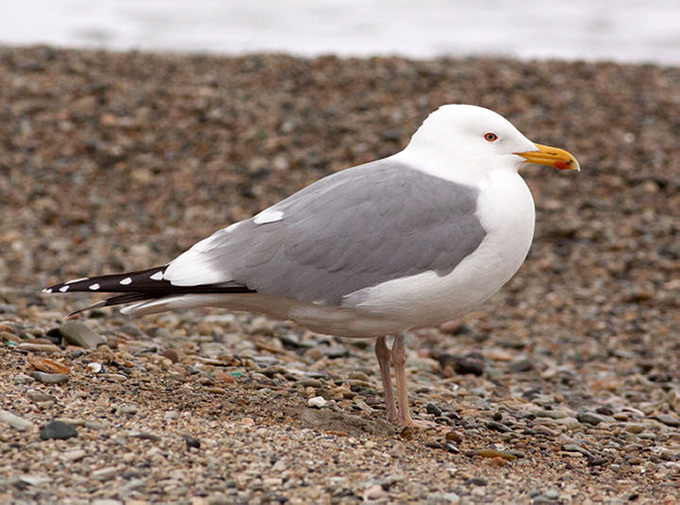
Cheorwon, National Arboretum, Song Do Tidal-flat, February 21

Following another VERY long drive, early morning at Cheorwon revealed apparently increased numbers of White-naped Crane along with the overwintering Red-crowneds. As the day progressed, we found probably four Solitary Snipe at the arboretum (where still very passerine-poor); while at Song Do, highlights in this much-degraded area included 202 Saunders’s Gull, 1200 Eurasian Curlew, 150 Far Eastern Oystercatcher, c. 2400 over-flying Baikal Teal, and best of all two first-winter Relict Gull.
Those claiming that there are new and improved policies in the ROK for wetland conservation need to visit this internationally important site (now largely impounded) and of course Saemangeum too.
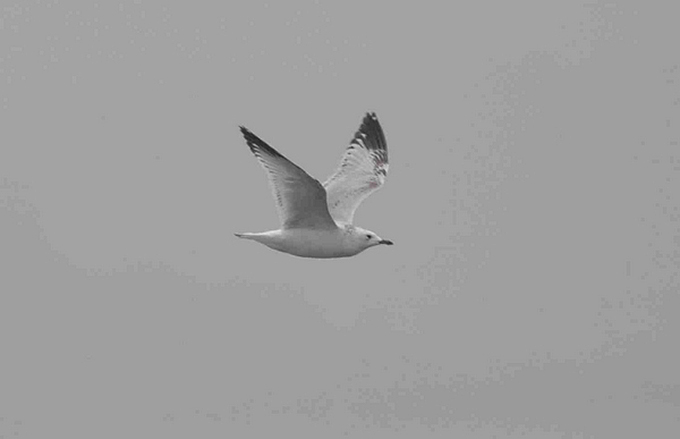
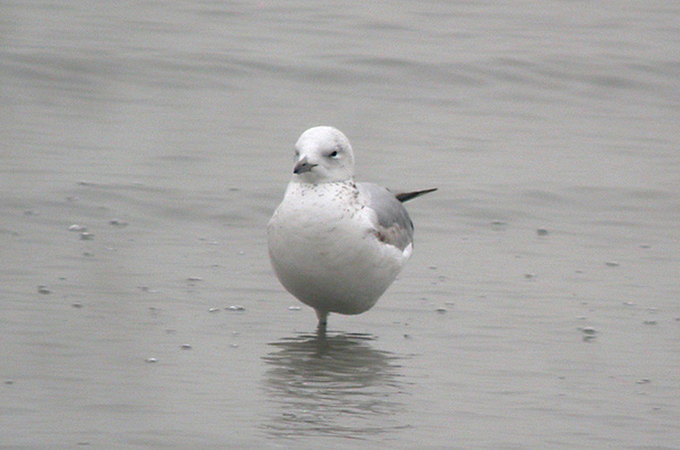
Gangneung-Northeast Coast, February 20
Following on from another extremely long drive, the morning started well at Gangneung, with excellent views of Siberian Accentor and short though decent looks at a possible female-type Canvasback or hybrid/odd Pochard (found and photographed here a few days earlier by local birders). This is a species that is regularly claimed in the ROK (with a flock of 14 on January 10th 1994, and 36 reported nationwide in 2003 during the Ministry of Environment’s annual winter bird census), even though to date there appear to be no ROK photographs of the species. On structure, the bird looked “very good”, being larger than accompanying Pochard in direct comparison, with an apparently proportionately bigger head, longer neck and bill. However, as can be seen in the excellent images taken by Dr. Shim Kyu-Sik a couple of days earlier, the same bird also shows some blue-grey on the bill (perhaps within range of Canvasback?), and unexpectedly heavily-mottled flanks – with the bird at most angles not appearing obviously paler than Pochard. One or two images of the bird showing the upperwing seem also to suggest more contrast than usually shown by Canvasback. Informed opinion on this bird’s identity, including by birders familiar with suspected hybrids, would be much appreciated!
From there, northeast up the coast, with three Steller’s Sea Eagle and Long-billed Plover at Yangyang, and off Hwajin Po, several hundred Ancient Murrelet, at least two Yellow-billed Loon, several Spectacled Guillemot and a close encounter with a Brunnich’s / Thick-billed Murre off Hwajin the obvious highlights.
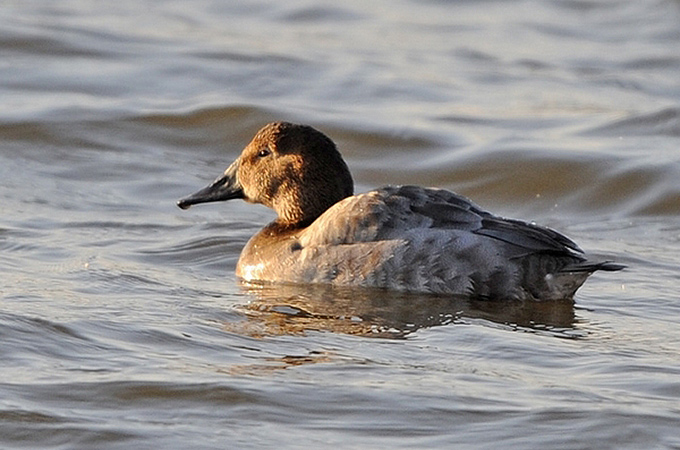
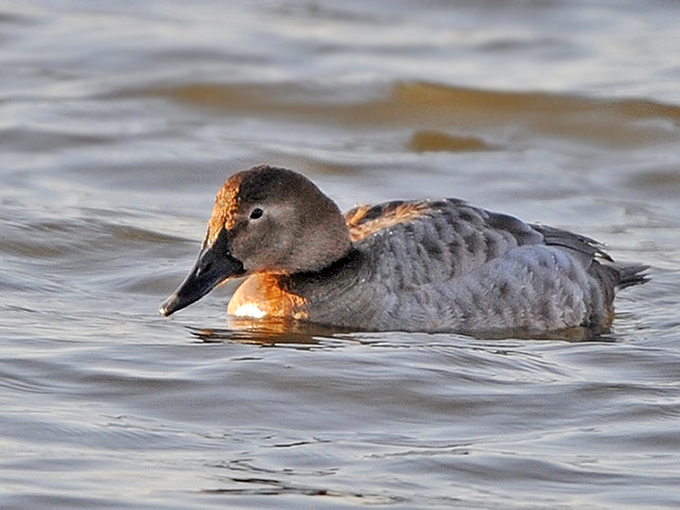
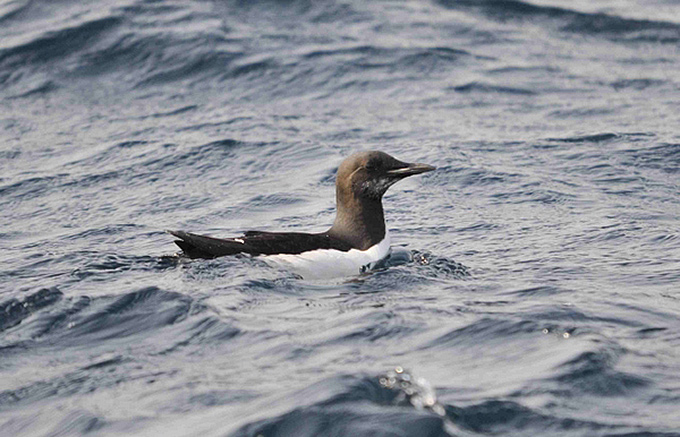
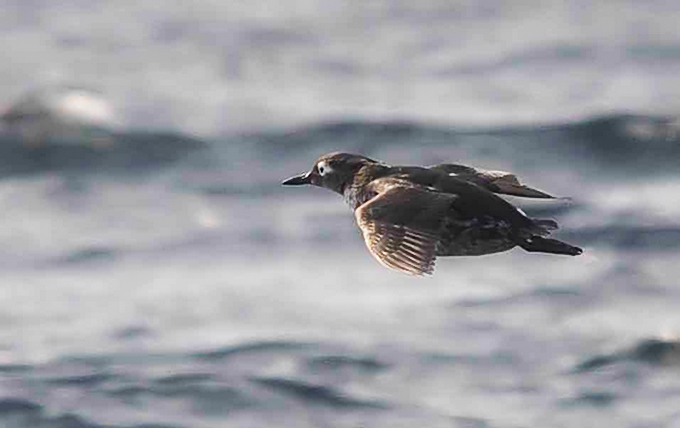
Han River, Seosan & Geum Estuary, February 19
In beautiful but chilly weather, excellent views of a couple of adult Steller’s Sea Eagle on the Han River (where also a Naumman’s Thrush) before a long drive down to the Geum Estuary via Seosan (where several Hooded Crane). At the Geum, the hoped-for Swan Goose flock was watched well in cold sunshine – where there was also a strikingly small and rather short-billed, straight-billed Dunlin (an atypically small individual, or perhaps, based on descriptions in a Pavel Tomkovich paper from 1986, one genuinely from Sakhalin?) and a pair of Falcated Duck. While there were no Baikal Teal on the Geum River, scanning through a flock of feeding dabblers near the estuary found one glossy-headed male and perhaps a couple of females, before the long drive back north.
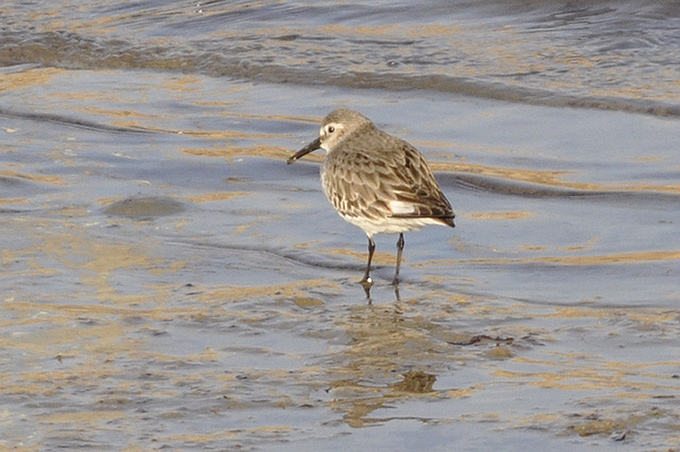
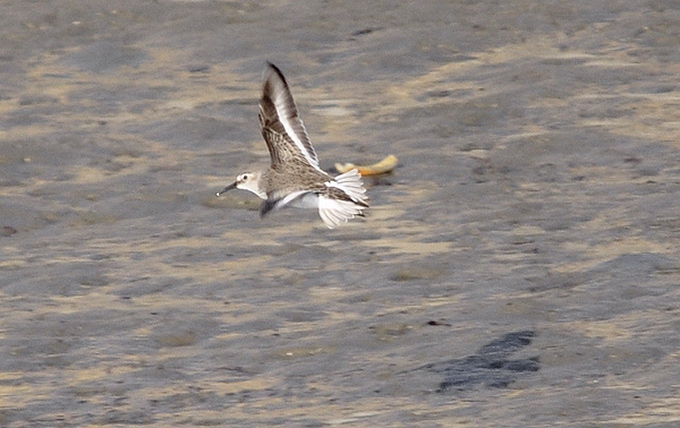
Suncheon Bay, February 12
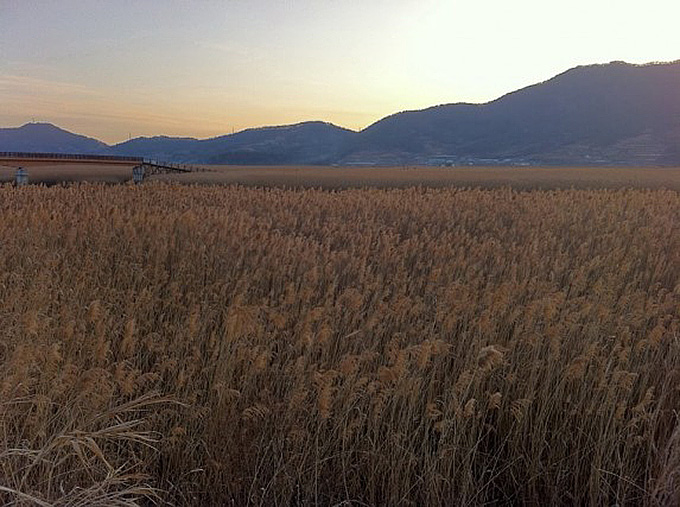
I woke up a bit after sunrise, for a quiet wintry walk along the reeds of Suncheon Bay. They were golden and swaying to the soft, cold wind. On this early Sunday morning, the neighbouring village seemed to be fast asleep. Several flocks of Bean Geese and Hooded Cranes bustled across the sky above me, which was wide and blue. I could hear the magnificent sound of their wings as they zipped by. I scanned the rice fields and saw several Oriental Turtle Doves feeding. I could hear a few Penduline Tits moving across the tops of the reeds, but couldn’t see them. A couple of Saunders’s Gulls were around the sandy beach area, as were some gorgeous Northern Lapwings occasionally twisting around in flight, a few Black-headed Gulls, Spot-billed Ducks, and Mallards. There were also Common Mergansers, Little Grebes, and a single Long-billed Plover.
After breakfast, more visitors began to show up at the park and so I retreated to a quieter area of reeds just north of the bay. Along the way, a group of four Hooded Cranes dropped down from the sky to to have a drink of water and perhaps feed along the stream between the reeds. There were also Eurasian Teal and Spot-billed Ducks at roost along the sandy bank. A larger group of a few hundred Hooded Cranes suddenly took to the sky noisily moving to a new rice field. As I watched them silently, I noticed at just a few meters in front of me was a Cinereous Vulture. It was tagged blue, number 10. This means it’s a rehab’ed bird which was tagged last winter in Korea before being released back into the wild.
After observing it for a short time, I continued on a trail through the reeds. I found a viewing point and sat quietly. There I sat, watching and listening carefully for the remaining morning hours. Across the stream, I saw my first ever Penduline Tit ! At first, I could only see one, but then realized there were quite a few feeding on the reeds. From this point on, my smile felt permanent. Common Reed Buntings and Pallas’s Reed Buntings were also feeding through this patch. As I watched and scrutinized, the call of a Black-faced Bunting seemed to get louder, until suddenly it appeared just about a meter away. It seemed curious. It stayed in view for a short time, hanging on the side of a reed, head turning side to side, investigating. Then it disappeared back into the reeds. I wondered if it felt as good as I did.
It was almost lunch time, which meant time for coffee. On the way out, I noticed a large, grey, dark crowned shrike-like bird with white underparts perched on a treetop. The heat caused waves so at that distance it was just too unclear. I scrambled to get closer for a better view, but wasn’t quick enough. I have yet to see a Chinese Grey, so I spent a short time looking around. No luck. I did notice an Eastern Buzzard sitting pleasantly atop a telephone pole. After coffee, Jack Dryden and Simon Downing joined me to watch the Reed Buntings and Penduline Tits. By now, the sky had close to two dozen Cinereous Vultures circling around. On our way out, pleased with our time well-spent, we promised to visit Suncheon Bay together again. We all agree it’s one of our world’s most beautiful places. Get out there soon, if you can !
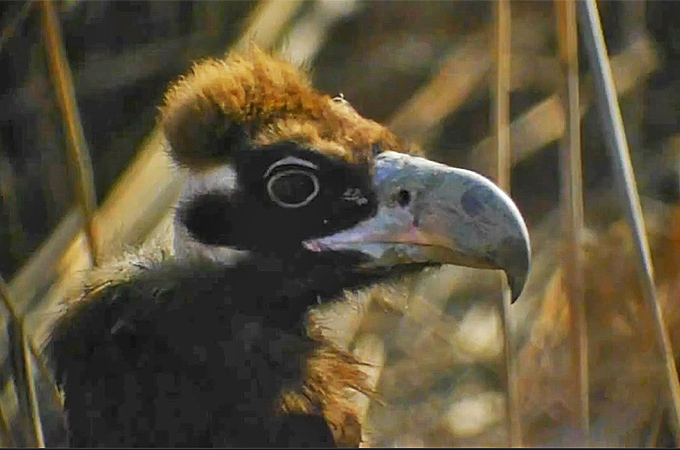
Cheorwon-NE River, February 12
Another day of glorious, windless sunshine, and some great birds. Overnight temperatures fell to -12C (rather milder than forecast), and the maximum briefly reached zero or even +1C. At Cheorwon, a fantastic FIVE species of crane were seen within 30 minutes. In addition to the regular Red-crowned and White-naped Cranes we found three Sandhill Crane, one adult Common and a single Hooded Crane (but learned there have probably been no recent sightings of the Siberian White there). Passerines were noticeably scarce, with no thrushes and no Rosefinches, but still included three Siberian Accentor, c. 150 Rustic Bunting and a singing Meadow Bunting.
The hordes of ice-fishers on the Tokyo reservoir (900 according to national news coverage) meant that few Cinereous Vulture were present there, and only 100-130 were seen during the morning. The only other raptor of note was a Merlin.
En route to the Northeast River, two Common Snipe were a personal first of the year for NM, while at the river itself, thawing hiking trails increased disturbance pressure on the Scaly-sided Merganser, with “only” ten or so seen (and several taking flight as hikers approached). Other birds of note there included three male Smew and a couple of gleaming male Falcated Duck.
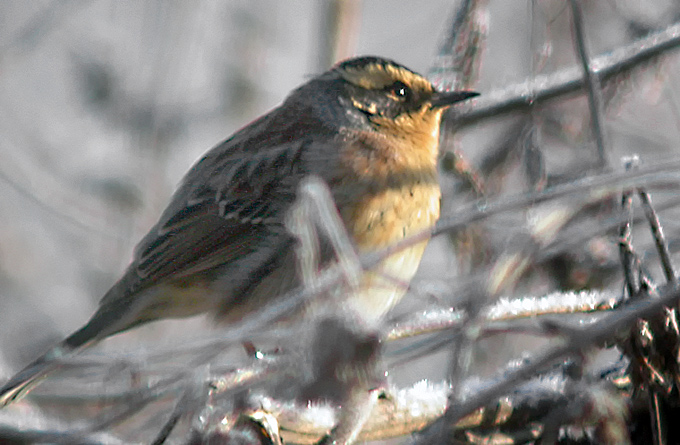
Namhansan Seong-Han River-National Arboretum, February 11
In beautiful weather (bright sunshine, great visibility and no wind!) at Namhansan, a cold (-9c) dawn started with a Hazel Grouse dozing in a tree by the road, and was followed soon after by the usual close encounters with Varied Tit and Japanese Pygmy Woodpecker. As earlier in the winter, there were no thrushes and the only finch was a single Brambling.
Then on to the Han River, highlight was three Steller’s Sea Eagle (two adults and a 2nd or 3rd Calendar-year) with several White-tailed Eagle out on the ice.
A few hours at the arboretum (much modified by various extravagant buildings, paved walkways and stone statues – like so many public spaces) was much less birdy than in a usual winter, but still included single Solitary Snipe and White-backed Woodpecker, and a couple of Brown Dipper (including one in song: an early harbinger of spring?).
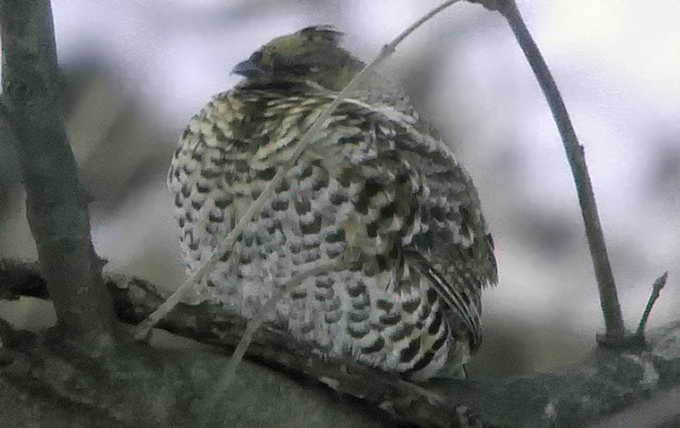
Uiwang Reservoir, February 11
The Uiwang reservoir and some of the adjoining channels were frozen. Waterfowl in the unfrozen parts included the usual Spot-Billed Ducks and Mallards. There were also a group of Rooks on the frozen part of the reservoir. There is a construction project going on in the South-East part of the reservoir but in the adjoining rice fields there were about 200~300 Bean Geese. Also present in the rice stubble, were several flocks of Skylarks (Northern or Japanese?) and Oriental Turtle Doves.
A Great Egret was flying around. There were also 2 Mongolian Gulls.
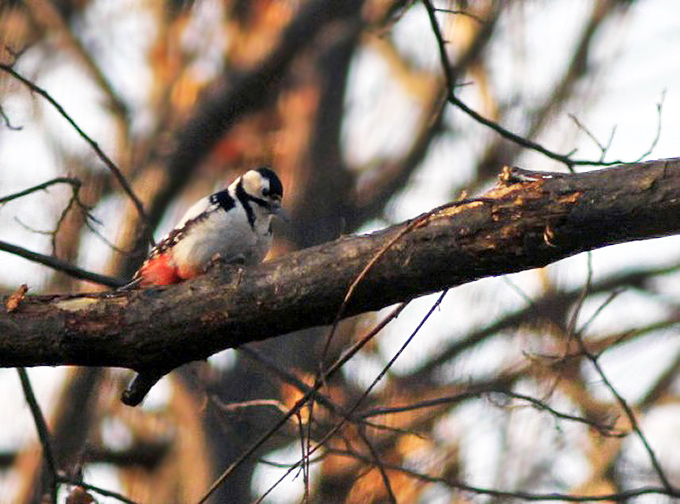
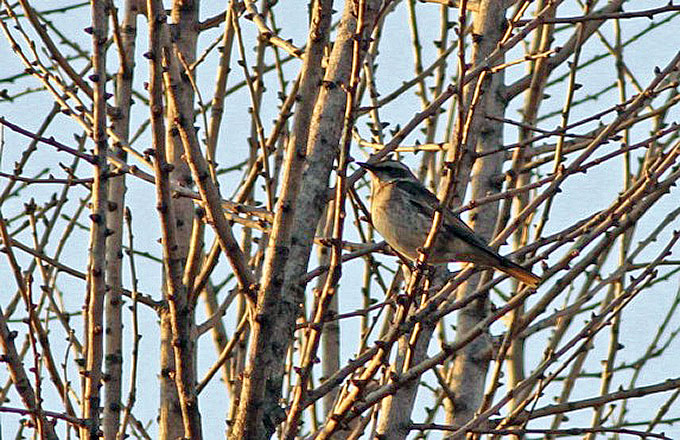
Other highlights of the couple of hours spent there in late afternoon included a playful Marsh Tit (along with several Great Tits), a Great Spotted Woodpecker, a Common Kestrel and a Dusky Thrush. The observations were from the North and North-western corner of the reservoir.
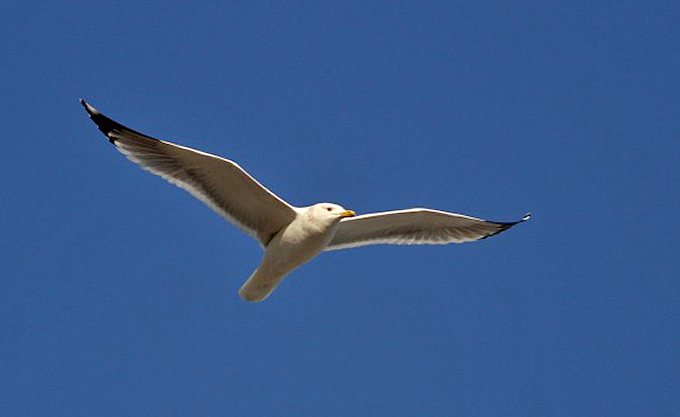
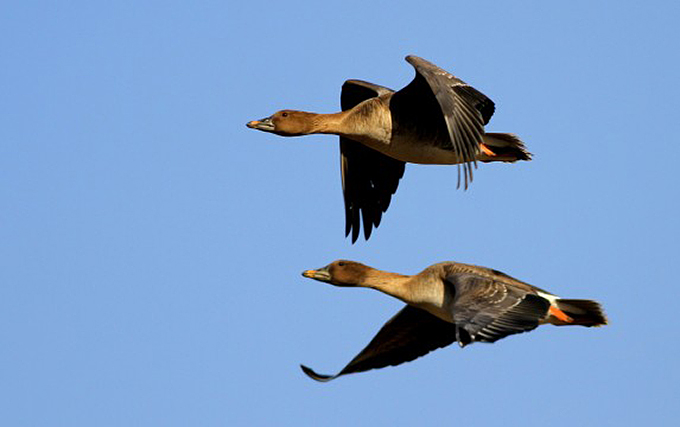
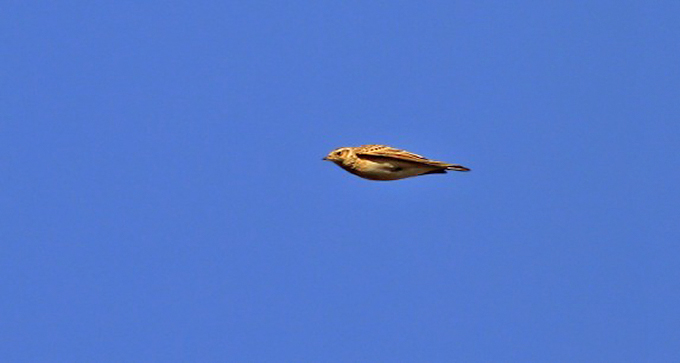
Gyeongju and Guryongpo Peninsula, February 3
Day One of a five-day survey of sites that have held Scaly-sided Merganser Mergus squamatus found a lot of ongoing construction, and no scalies. Happily, a quick 3 hours birding in subzero temperatures on the Guryongpo Peninsula was much more interesting. The first stop, in Seokpyeong Village, found two Light-vented Bulbul sunning themselves in some berry-laden trees. Along the coastline, in among a large number of Slaty-backed Gull (three main groups contained at least 1500 birds) were two Glaucous-winged Gull and a couple of fascinating ID challenges!
The first was a white-winged gull…It was clearly smaller than most (or even all) of the vegae, and images taken (taken through an ageing Nikon coolpix and a brand-new set of Swarovski gear – on which much more in a later post!) show its fairly rounded head shape and bill pattern more suggestive of Iceland than Glaucous Gull. Its primaries showed no dark markings.
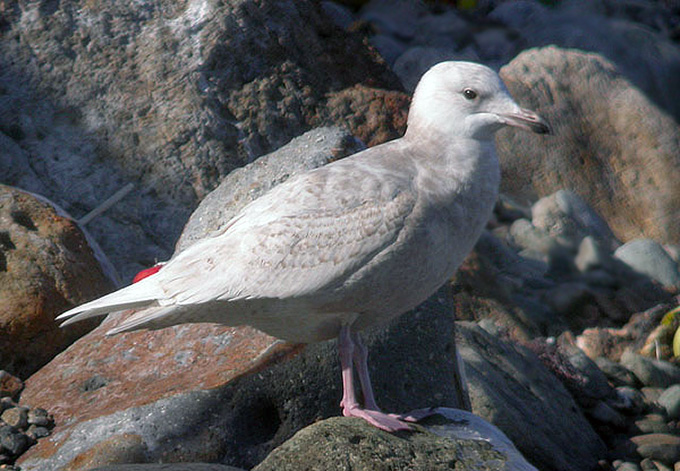
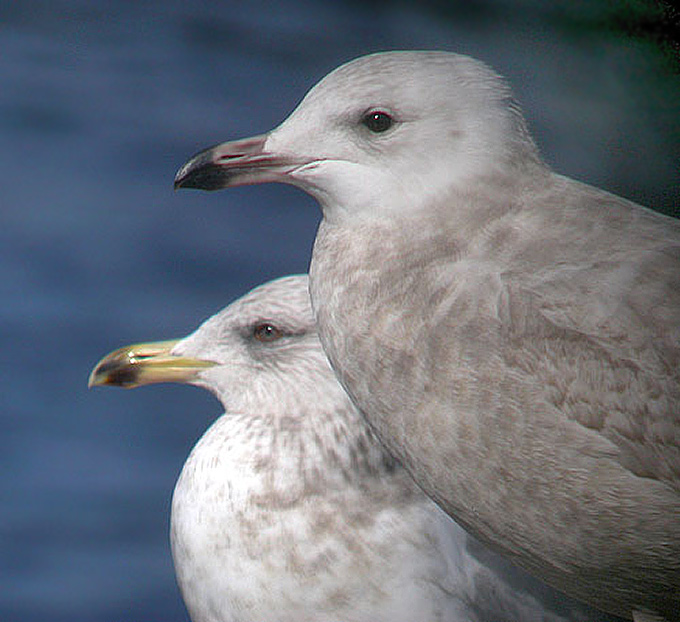
Such “glaucoides-types” appear to be annual in the ROK. Is this one an Iceland? A small (female) barrovianus Glaucous with an atypical bill pattern? Or is it one of the enigmatic birds described in Malling Olsen’s Gulls (according to which “An undescribed taxon might occur in N Russia:…smaller, tamer adults…brighter eye-ring and yellower iris; accompanied by smaller, grey immatures…a pair found nesting…female had bright lemon iris, orange orbital ring and measurements similar to large Iceland Gull…Such birds were even found at four sites in Novaja Zemlja” P.216, First edition). How too about the bird identified as an Iceland Gull in the Birds Korea gallery (at: http://www.birdskorea.org/Gallery/Species/BK-GA-Larus-glaucoides.shtml)?
The second ID challenge appeared at first sight to be a fairly straightforward adult American Herring Gull (recorded scarcely annually in the ROK).It was heavyset and glaucous-pale on the saddle (like most such adults here – presumably as from the paler, western part of the population); dirty-brown collared, with primaries showing much black and thick white tips; had very pale eyes (with orangey eye-ring), and a pale-based bill with a fairly obvious dark mark. However, the undersides of the primaries were pale grey, and there was some grey admixed in the primary black suggesting a hybrid origin.
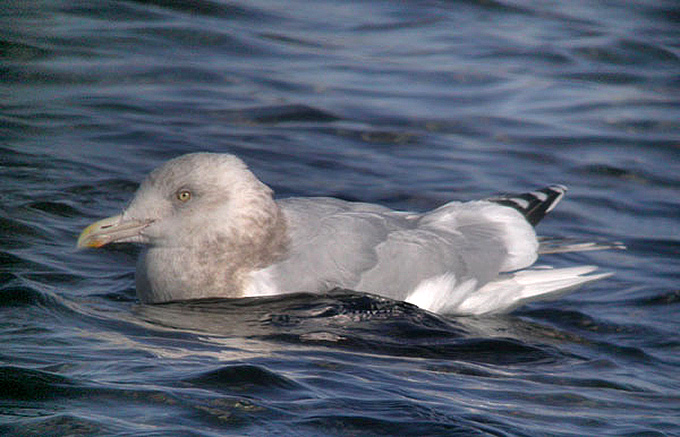
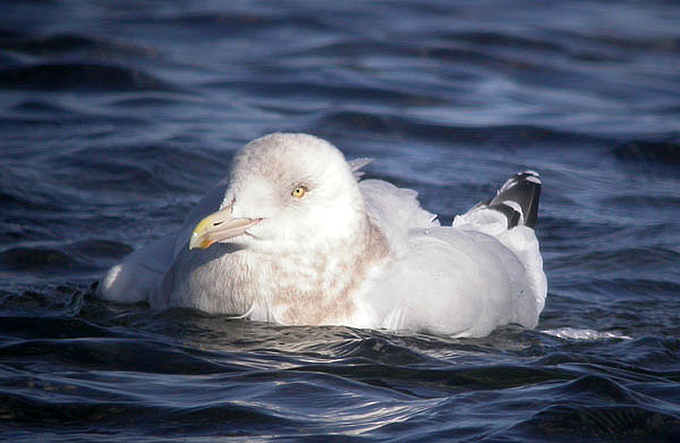
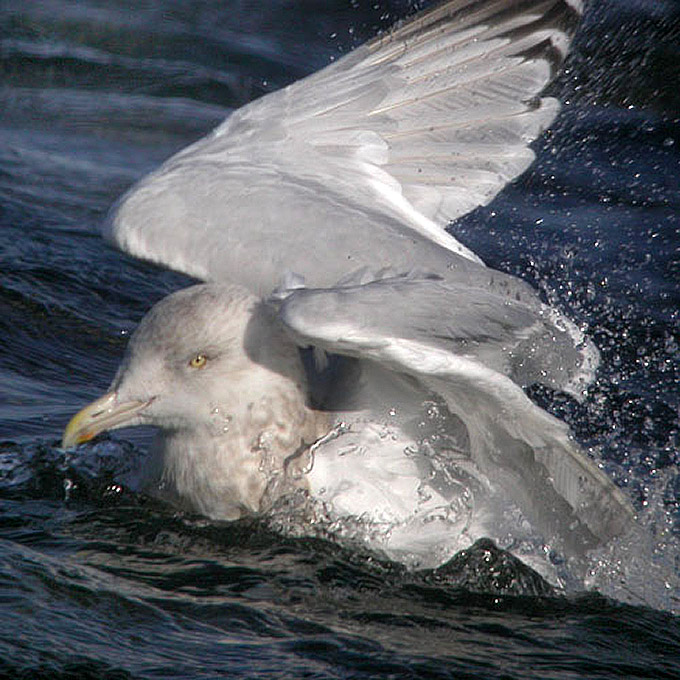
Hybrid American Herring and Glaucous Gull have been recorded in North America and Europe. However, based on range perhaps Vega x Glaucous would be more likely. Is this the explanation for this striking individual? As with the white-winged gull above – all comments welcome!
Other birds of note in the short time available found on rough seas included two Black Brant, 38 Rhinoceros Auklet but only 17 Ancient Murrelet, 50 Harlequin Duck, at least 500 Pacific Loon and my personal highest day count to date of Red-breasted Merganser – with at least 1600 present.
